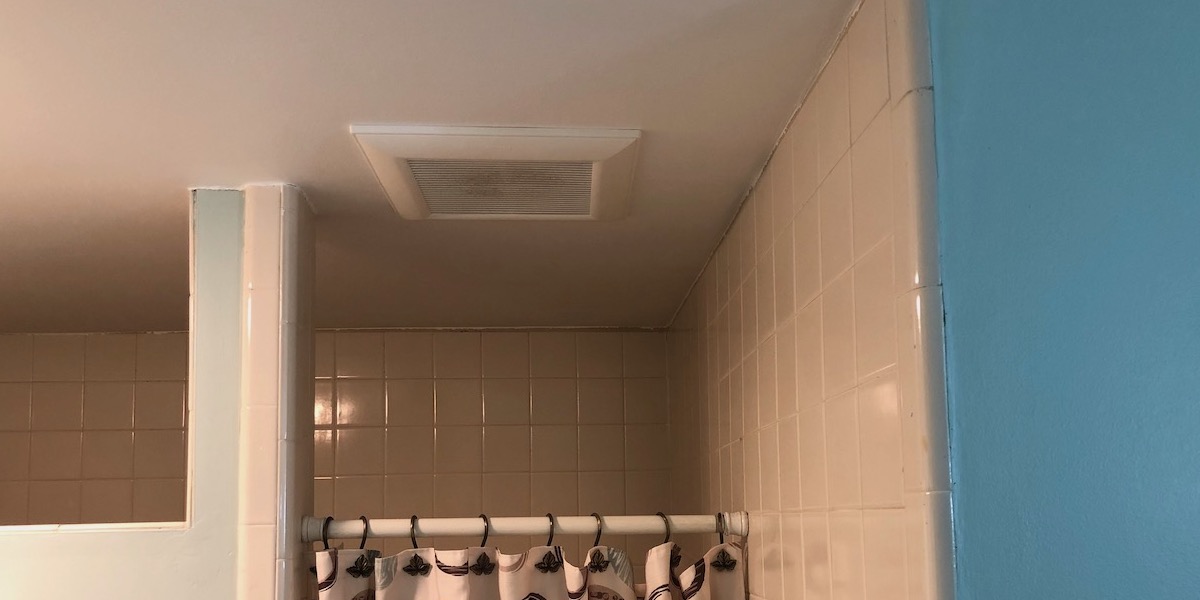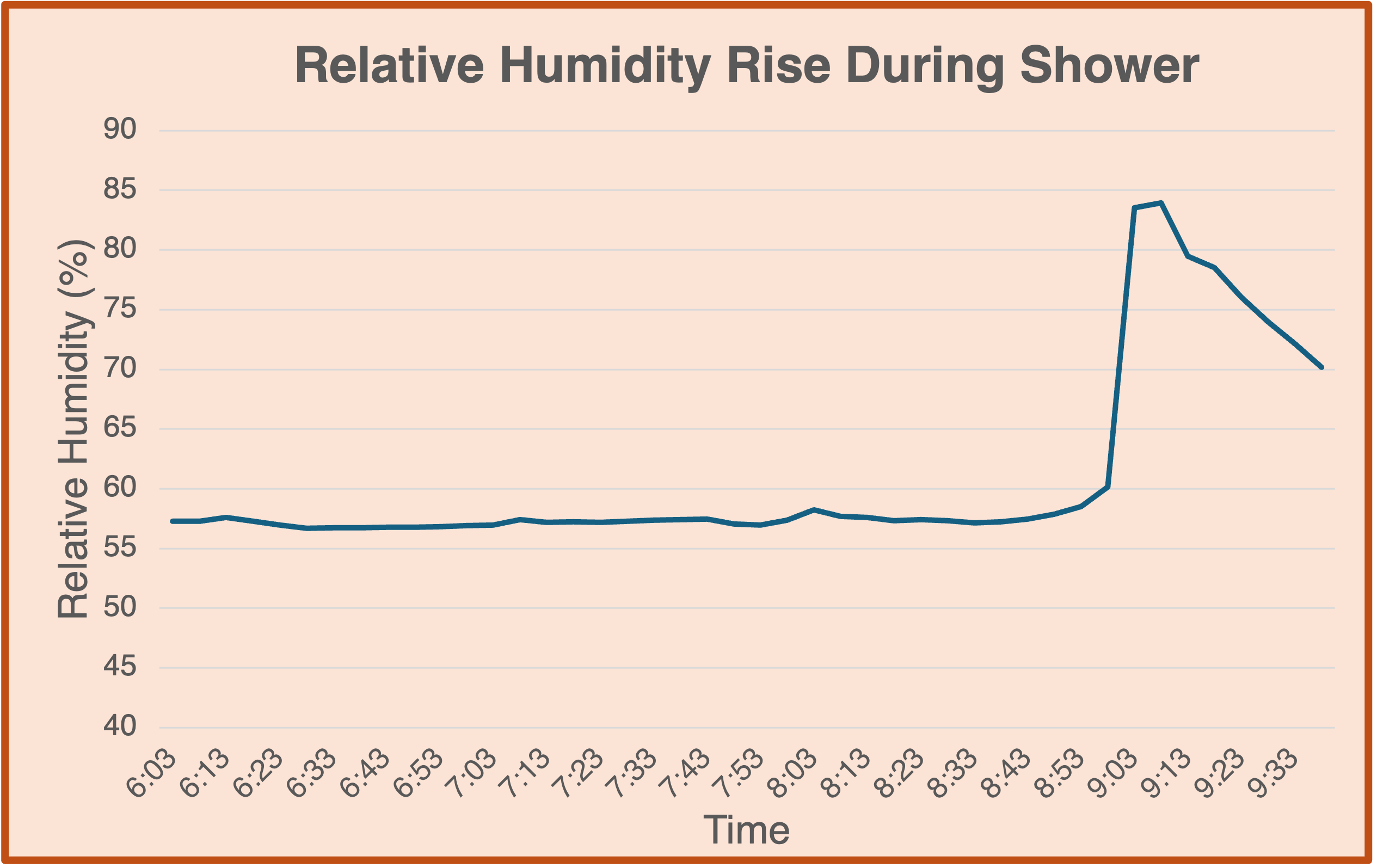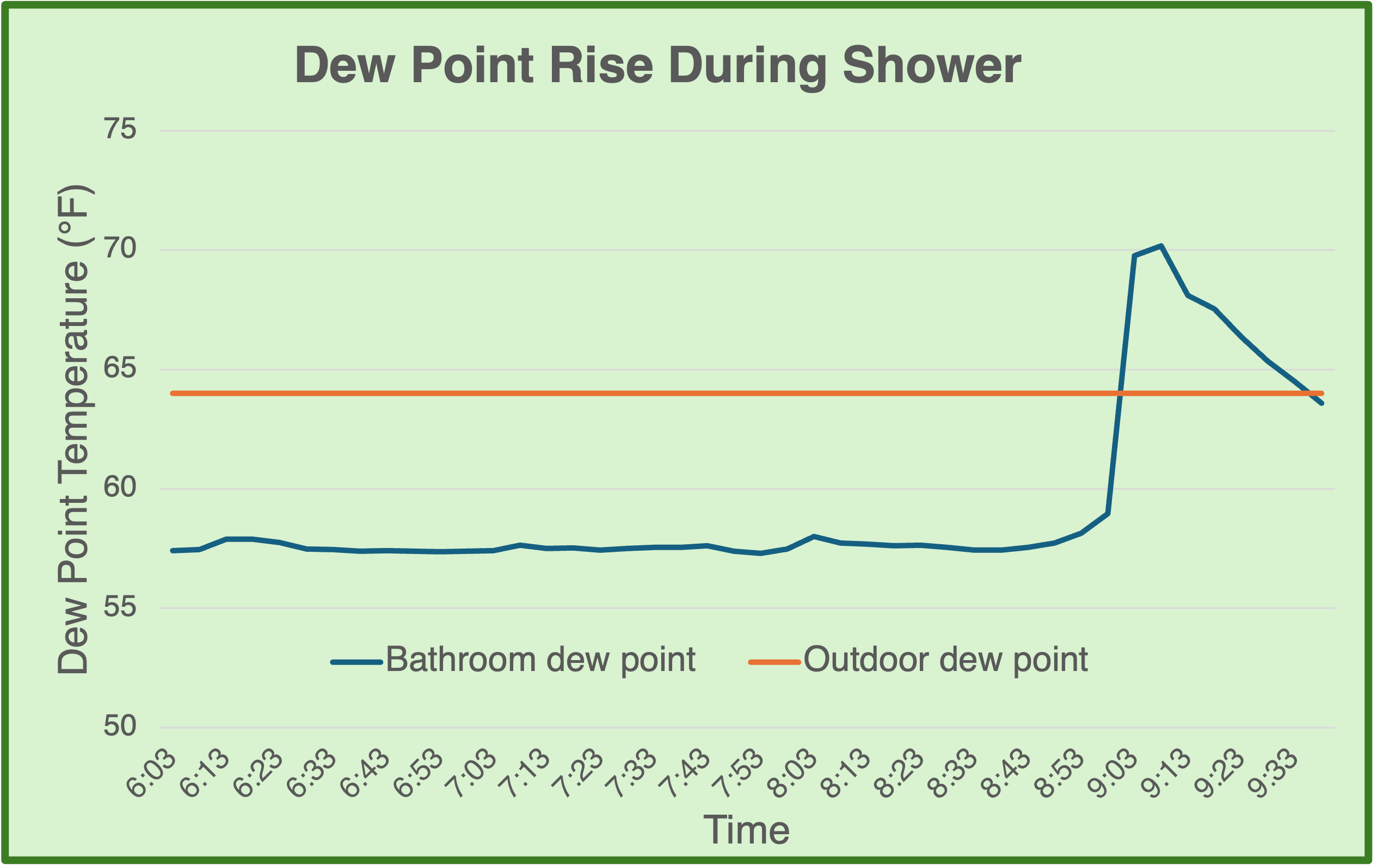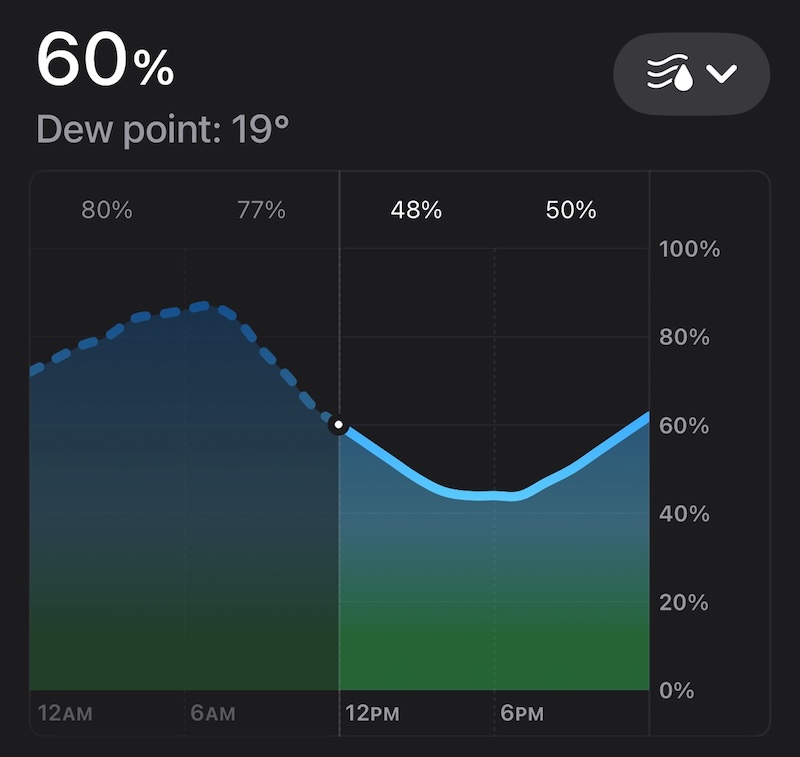Do You Really Need to Run the Bath Fan in Summer?

In the comments of my last article, RoyC made an interesting point. “I don’t usually run my bathroom exhaust fan during a shower when it is hot and humid out,” he wrote. I’m sure that statement shocks a lot of people. And why wouldn’t it? It goes against everything we’ve been told about controlling moisture in our homes, right? Well, maybe not everything.
You may recall that I wrote an article a few years ago on the same exact issue, except for winter instead of summer. My conclusion was that you may be able to get away with leaving the bath fan turned off during and after your shower. Even better than saving energy, though, that moisture you add to the air in the bathroom may help improve your indoor humidity in winter.
A look at relative humidity
So, back to our question about summer showers and bath fans. We all know that the relative humidity in the bathroom rises when you take a shower. Here’s a graph of my morning shower today. It didn’t hit 100 percent, but 85 percent isn’t the kind of humidity you want in your house for very long. Hence the advice to run the bath fan.

But if you’ve been reading this blog for a while, you’ve probably noticed that I’ve been trying to wean people off of thinking about humidity in terms of relative humidity. It’s a perfectly valid psychrometric quantity. The problem is that too many people misunderstand it, which leads to bad interpretations of what’s happening. So let’s look at the more relevant metric.
What’s up with the dew point temperature?
The dew point temperature is where we need to look to answer the title question. When you turn on the bath fan, you’re exhausting air from the bathroom. You do get local removal of humidity, but bath fans do more than just remove air from the bathroom. They create a negative pressure, which results in outdoor air leaking into the house.

The graph above shows how the dew point changed during my morning shower. You can see that it went up from about 58 °F (14.5 °C) to 70 °F (21 °C). At the same time, the outdoor dew point was at 64 °F (18 °C), shown by the orange line on the graph. (Drier, cooler air just moved into the Atlanta area, and it’s going to be a beautiful week here!)
Because exhausting the humid bathroom air leads to an equal amount of outdoor air coming in, running the bath fan during the 30 minutes of elevated dew point would help dry out the house. But if this morning had been one of those days with a 75 °F (24 °C) dew point, I’d have made things worse by turning on the fan. Hmmmm.
Another thing to notice is that the dew point came down fairly quickly after I turned off the hot water. Within 30 minutes it was the same as the outdoor dew point. And here’s the thing that may surprise you. I did NOT have the bath fan turned on.
Yeah, we did get a little excess humidity in the house during that time. But the mirrors didn’t get steamed up and the walls weren’t dripping, so it was OK even in our current conditions.
The effect of air temperature
But what about the air temperature (called dry bulb by psychrometric geeks). Here’s another part of RoyC’s comment:
When I get done mowing the lawn on a day where it is 95 F DB and 75 F DP outside and take a shower, my bath fan would be exhausting 75 F saturated air (DB and DP) at best while causing additional air to be sucked into the house somewhere else at 95 F DB and 75 F DP. Thus, I haven’t reduced my latent load, but I have increased my sensible load.
Even if you might be dehumidifying because the outdoor dew point is lower than the indoor dew point, you still may be adding to your air conditioning load. As he wrote, an even exchange of moisture that brings in hotter outdoor air will cause the AC to do more work.
How to make the call
This is much like my article on how to decide when it’s too humid to open the windows. You start by comparing the indoor and outdoor dew points. But you don’t have to measure the actual dew point to make a decision. Just follow these three steps:
- Assume the dew point in your bathroom is the same as the bathroom air temperature. If the air in your bathroom is 75 °F (24 °C), that’s your maximum dew point. That happens when you hit 100 percent relative humidity. If your relative humidity is lower than 100 percent, your dew point is lower than your air temperature.
- Look up the outdoor dew point on your weather app. (You can see in my screenshot below that the dew point here in Atlanta is 19 °C (66 °F) as I write this.) If the outdoor dew point is lower than your bathroom’s, you’ve met criterion number one.
- Finally, check the outdoor air temperature. If it’s the same or lower than your indoor temperature, you’ve met criterion number two.

If you pass both criteria, go ahead and run the bath fan. If it’s hotter or more humid outdoors, you may not need to run the bath fan. Another consideration, of course, is how wet things get in your bathroom if you do leave the bath fan turned off. If you shower with the bathroom door open and have good air circulation, leaving the bath fan off should be fine.
Allison A. Bailes III, PhD is a speaker, writer, building science consultant, and the founder of Energy Vanguard in Decatur, Georgia. He has a doctorate in physics and is the author of a bestselling book on building science. He also writes the Energy Vanguard Blog. For more updates, you can follow Allison on LinkedIn and subscribe to Energy Vanguard’s weekly newsletter and YouTube channel.
Related Articles
Do You Really Need to Run the Bath Fan in Winter?
Make Dew Point Your Friend for Humidity
When Is the Humidity Low Enough to Open the Windows?
Comments are welcome and moderated. Your comment will appear below after approval.

This is a lot to think about before my morning shower. I don’t know if I’m capable of all this.
Alyce: Yeah, sorry. Here’s an easier method that might work for you. Just monitor the bathroom. If you get a lot of condensation on the mirror, run the fan.
I like bath fans to have timers – have them stay on for an interval after use but not all day.
I think there is a bit more to consider – I certainly appreciate the consideration of outdoor dewpoint and its impact on the decision to exhaust bathroom air after a shower. This has inspired me to make some measurements of my own.
My other consideration is to get at least 1-2 air changes through the bathroom to aid in drying wet surfaces, since wet surfaces particularly grout lines, tend to grow mildew, which I dislike having to manually clean. If some extra minutes of bath fan operation causes a bit more load on home AC system, that’s a price I’m willing to pay if in exchange my grout grows less mildew.
And running the air conditioner a little longer will also reduce the humidity.
Curt: I also prefer timer switches. I currently have a condensation sensor, and it drives me crazy. I just ordered a timer and it’s supposed to arrive on Thursday.
Good point about moisture on the grout, but how quickly would a bath fan actually help dry it out after being pelted by the shower?
Hi Allison. I am still trying to understand if this is a problematic issue or not. The air exchange rate (cfm/ft3) for the bathroom is large due to its presumably small volume compared to the rest of your house. If the same volume of outdoor air enters the entire house through many air leaks, the air exchange rate is low, and the humidity is diluted. It seems to me that using an exhaust only bath fan is a bigger issue in a tiny house (high proportion of bathroom volume to total house volume) or if you leave the bathroom window open when outdoor dew point is higher than indoor dew point, and that muggy air enters the bathroom. Thoughts?
John: My first thought on reading your comment is that I don’t think I’ve ever seen anyone use cfm/ft^3 instead of air changes per hour (ACH). To your main question, though, the amount of air being sucked in through random leaks in the building enclosure may or may not be a problem. If the fan stays on a long time with humid air hitting a cold surface, it might lead to significant moisture accumulation in porous materials, which can cause mold growth. And even if a bath fan moves a small amount of air in total, if most of it gets sucked in through one leakage area, that could be a problem.
Great read. I have a master bath from 1970 so it’s tiny. My guess is it get to 90-100% humidity fairly quickly during a hot shower. I think it could make sense to run the fan for a few mins to rid the humid air for a small bath and minimize condensation on surfaces and potentially inside the walls.
Eric: I agree. I think running the fan for a few minutes, just to clear out the heaviest load of humidity, is fine.
I will add a couple more comments now. My bathrooms do have supply air registers so when it is hot and humid outside, the AC is typically circulating air through the bathroom, at least part of the time, so it dries out pretty quickly.
Allison mentioned comparing both the outdoor dry-bulb and dewpoint temperature to the indoor bathroom temperature assuming that its dry-bulb and dewpoint temperatures are the same. You can do the same thing by just comparing the outdoor wet-bulb temperature to the bathroom dry-bulb temperature since the wet-bulb temperature of saturated air is also equal to the dry-bulb temperature and wet-bulb temperature is a direct measure of the total energy content (enthalpy) of the air. So if the outdoor wet-bulb temperature is higher than the indoor dry-bulb temperature, leave the fan off.
Roy: There you go making sense again.
Could this be why some recommend having an automatic dehumidifier in the bathroom instead of an exhaust fan?
Richard: Yes, the dehumidifier would take the place of the bath fan. That would presumably be a way to deal with the humidity without changing the house pressure. I’m not sure it would save any energy because a dehumidifier operates at about 500 W, a good bath fan could be as low as 5 W.
I usually take a slightly warm shower in the summer and then rinse in cold water. I have not measured the effect but the cold water appears to cause the moisture to condense. When we finish the shower we always squeegee off the shower glass and walls. Seems to make a huge difference in glass cleanliness and bath humidity.
Charlie: The more water you send down the drain, the less there is to evaporate into the air.
Sounds nice but if you live in Texas there is no cold water in summertime 😂
I used to work for Carrier and learned a little about their history. Willis Carrier’s first AC system just sprayed chilled water into the air stream which would then cool and dehumidify the air. I am guessing that it also helped clean the air. This was used in textile factories where humidity control was important.
I’ll have to say that your idea of summer and what my idea of summer is are two very different things. Your summer is our early spring and late fall…
I’m going to have to watch the temp and humidity in our bathroom but I will say that if it’s 74 when you walk in it will be 85-90 and 100% humidity within minutes of starting to take a shower with the bath fan on…
It’s just before the hot part of the day and it’s 105* and a dew point of 64*. It will vary a little on the days when the heat comes but the RH outdoors rarely ever goes under 25% when temps are over 105*. Sadly I lost all my weather station logs of the summer when it was 117* for an entire week so I have no idea what the dew point was then.
But before doing the testing with the numbers I have seen that if you don’t run the fan in the summer it results in a massive humid heat plume that works it’s way through the house and extends AC run time. Running the fan confines the heat and humidity to the bathroom and it doesn’t have a huge effect on AC run time. However I do find that running the fan until it’s stable with the rest of the house will change that and result in longer AC run time.
In TX you do everything you can to reduce heat production in the house and then to exhaust it ASAP. The AC will be running most of the day anyway and it won’t mind dealing with a little humidity.
That said I am happy that the insulation I did last winter has resulted in a massive decrease in electricity usage this summer. About $75 less than we expected to pay last month. And we can keep the house cooler and more comfortable and the AC will eventually cycle when it’s 106 so when we get the hot days over 110* it will run non stop. That said I would like more capacity in the form of a minisplit or other backup unit. Here no one ever has ever had the illusive problem of an oversized AC unit… It is simply not possible here.
Extra capacity would make it possible to cook and shower in the afternoon and evening. As it is you learn not to do that….
May I ask Mr. Adams what part of Texas? There is quite a difference depending where you are. As I write this dewpoint is 72 in Dallas, 76 in Houston, 81 in Galveston and 56 in Austin(!).
I am west of Fort Worth which is quite a bit hotter than Dallas. If you are familiar with the area 360 is the dividing line and there is a reason they say that Fort Worth is where the west begins. Sadly the official chamber of commerce weather station is by 35C at DFW airport (Technically Fort Worths airport if you know it’s history) which is always cooler in the summer and warmer in the winter than where people actually live.
I’m also by the lake and have allot of oak trees which helps make our microclimate different than others. Also the rain generally goes around this area so everything is dry crunchy and bare dirt so the temps go up more here as well.
I would like to see Allison do some research on the impact of yard type in regards to heat. A property with a nice green yard is cooler than one with a zero scaped yard. I see aero scaping doing nothing but causing the heat island effect to increase exponentially. That cooler air around the house also lessens the load on the condenser…
FYI I go by my weather station and others around me to make sure it’s in the ball park.
Robert it was no so hot here in Houston today-102 @74F DP.
We do run the fan during a shower and about 15 minutes after.
Fun stuff, as usual. I am wondering, though, if we are to propagate the right ventilation behavior to the average non-psychrometric citizens, we need something simpler. Wet bulb, dry bulb, are you kidding me!? It’s like Data (in Star Trek) talking about love: “experience certain sensory input patterns.”
When we vent a bathroom after a shower, we’re not interested in temperature, for the most part. We’re interested in moisture and all this dew point stuff is cool, but non-intuitive. Give me a gadget that will display humidity ratio (pounds of moisture per pound of dry air) for outdoors and indoors. Then I will ventilate, or not.
Then it’s also not obvious where this gadget should be located. In the bathroom? In the hallway outside the bathroom? In the walk-in closet if connected to the bathroom? I get uncomfortable with non-deterministic paths for infiltration, and so it’s always fan on, window open for me.
I enjoy the psychrometric analysis for bathroom ventilation, but in the end I just use simple observations based on trial and error. In the winter when I know the heating system is running a significant amount of the time, I don’t use the bath fan because the additional humidity is generally useful. In the summer when I know the cooling system is running a significant amount of the time, I also don’t use the bath fan because I know the cooling system will remove the additional humidity. During mild weather conditions when there is not much heating or cooling operation, I do use the bath fan. If water is condensing on any surfaces during any season, I use the bath fan. This is the part that I learn through trial and error. I do keep a cheap temperature/humidity sensor in the bathroom to be sure that the relative humidity is not getting too high.
I could develop an expensive control system to do all of this, but no one would buy it 😉
I not only use the bathroom fan for showers and when I dry my hair afterwards, I also sometimes use a dehumidifier in the bathroom (with the door nearly closed) for about 20 minutes after my shower. If I don’t use the bathroom fan, moisture immediately condenses on the mirror and on the shower-stall walls, except in really hot weather. Since I added a dehumidifier to my bathroom routine, there’s no longer any black mold growing on the caulk, as it had been previously. Note: when I last used a portable (hose out window) air conditioner in the bedroom next to my bathroom in very hot weather, I found that moisture condensed onto the glass and metal doorknobs in the bedroom (and probably on other things as well). So next time I use that, I will add the dehumidifier as well in the hall next to that room, to reduce the humidity. Note that I have excellent wiring, with separate 20-amp circuits for the A/C unit and the dehumidifier. I’m in Seattle, WA so we don’t have weather extremes as great as in other parts of the country, but we finally reached 100 degrees in 1994, and 108 in year 2021. I use my A/C as little as possible since I figure that ANY type of power use contributes to climate warming, including the hot air produced by the A/C unit.
I really like learning new things, and this is one of them as well. But theres also learning things, and putting them into real world practice. As the one post said “This is a lot to think about before my morning shower.”
And I agree, I dont check a thing in the morning before my shower. My phones off, I get out of bed and shower. And for all these years of home ownership, have always ran the fan.
As well, try explaining this to your family and have them track the weather to use the fan or not? Or guests as well. Lets be honest, it wont ever happen.
I am huge into humidity mitigation in my house. I have remote gauges all over the house I keep my eye on alot. I mean a bathroom fan may cause a negative pressure and bring in the outside air, which may be as humid. But its all over the house, not just one room.
In winter here when it gets cold, we are supposed to have 15% humidity at -35 Celcius. Can it be accomplished, very hard to do. Ive been close, 20%, and it was so unbearably dry in the house, it just wasnt feasible. Plus with the low of a humdity you run other health risks. So you save you house, and risk your personal well being. Theres science, and then theres “real life”
While this all makes sense, lets face it, its not a fucntional way to live.